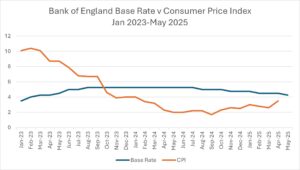
Amidst the confusing and complex UK tax system, quirks in the tax rules often lay traps for the unwary, which can seriously damage your wealth. Amongst these are so-called “cliff edges”, where a small increase in income leads to a disproportionately large loss in benefits or a sharp rise in tax. You can, however, avoid these traps by sensible financial planning.
60% Marginal rate of Income Tax
One of the most striking cliff edges occurs when an individual’s income exceeds £100,000 in a tax year. Most people are familiar with the progressive tax bands of basic rate, higher rate and additional rate income tax; however, less well known is that the Personal Allowance (i.e. the amount that an individual can earn before tax is payable) is tapered once income exceeds £100,000 and is completely lost once income exceeds £125,140.
With £1 of the Personal Allowance being lost for every £2 of income above £100,000, this creates a marginal tax rate of 60% on earnings between £100,000 and £125,140, as the individual not only pays 40% income tax, but an effective 20% tax on top in respect of the lost Personal Allowance. Once National Insurance is considered, an employed individual takes home just 38p out of every pound of salary earned between £100,000 and £125,140.
The £100,000 threshold also impacts the ability for working parents to obtain Tax-Free Childcare. This Government scheme provides up to £2,000 per annum towards childcare costs, based on the level of contributions made. For example, paying £8 into the childcare account will result in a £2 top-up from the Government. To qualify you (and your partner, if you have one) both need to be in work and receive at least the national minimum wage; however, if either parent earns more than £100,000, you are ineligible for the scheme. Likewise, any parent with income above £100,000 would also lose 15 hours’ worth of free childcare that is available for 3- and 4-year-old children.
Take action to save tax
The cliff edge when income exceeds £100,000 can certainly have a disproportionate impact on the amount of tax paid and eligibility to certain benefits. The good news is that those affected can take steps to bring their net adjusted income below this threshold and save significant amounts of tax.
Any pension contribution made by an individual into a personal or workplace pension will reduce their net adjusted income, as the pension contribution effectively extends the basic rate band by the amount contributed. For example, an individual with income of £110,000 would lose £5,000 of their Personal Allowance. By making a net pension contribution of £8,000 (£10,000 gross), their adjusted net income falls to £100,000, thus restoring the Personal Allowance in full and making an effective 60% tax saving.
Those considering pension contributions should be aware that there are limits to the amount you can contribute to a pension each tax year, and higher earners may be subject to a lower annual pension allowance.
Pension contributions are not the only way to reduce your adjusted net income. Donations to charity which are eligible for Gift Aid would also have the same effect of reclaiming the lost Personal Allowance.
Inheritance Tax Taper
Tax cliff-edges do not only apply to Income Tax. Inheritance Tax rules also use tapering, which add further complexity to an already unpopular tax.
The standard nil-rate band, which is the amount an individual can leave to loved ones on death is £325,000, and assuming a married couple leave everything to each other on the first death, the nil-rate band is transferable, so that the second of the couple to die can leave £650,000 free of Inheritance Tax.
Since 2017, an extra residence nil-rate band has been available when passing on a residence to direct descendants. This is currently worth £175,000, bringing the potential total Inheritance Tax-free threshold for a married couple to £1 million; however, the residence nil-rate band is reduced by £1 for every £2, where the net estate is worth more than £2 million. By way of example, an estate valued at £2.7m would fully lose any residence nil-rate band, leading to an additional £140,000 Inheritance Tax liability.
It is important to regularly consider your Inheritance Tax position, so that action can be taken to reduce the amount of tax paid by your estate. You should, however, bear in mind that the value of the estate on date of death – and not now – will form the basis of any Inheritance Tax paid, and growth in the value of assets over time should also be considered. Furthermore, the value of defined contribution pensions that are unused will form part of your estate from April 2027 onwards.
There are a range of strategies that can be used to reduce the value of an individual’s estate for Inheritance Tax purposes. Gifting is the most obvious way of reducing the value of the estate; however, you should also carefully consider your own financial needs in later life, which may involve care costs, together with any unintended tax consequences on the recipient of the gift. This is where independent financial planning advice can help in looking at your personal circumstances, to consider the most appropriate plan of action.
The benefit of personalised advice
We have highlighted cliff edge tax thresholds that effect both Income Tax and Inheritance Tax, which can lead to disproportionately higher levels of tax, and for working parents, could also impact on assistance with childcare. Our experienced advisers at FAS can consider your personal financial situation and provide advice on effective ways both to reduce your tax burden and ensure your investments, pensions and other arrangements are professionally managed and reviewed. Speak to one of the team to start a conversation.
















